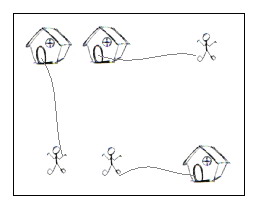HDU 1533 Going Home(最小费用流)
Posted jhcelue
tags:
篇首语:本文由小常识网(cha138.com)小编为大家整理,主要介绍了HDU 1533 Going Home(最小费用流)相关的知识,希望对你有一定的参考价值。
Going Home
Time Limit: 10000/5000 MS (Java/Others) Memory Limit: 65536/32768 K (Java/Others)Total Submission(s): 3278 Accepted Submission(s): 1661
Problem Description
On a grid map there are n little men and n houses. In each unit time, every little man can move one unit step, either horizontally, or vertically, to an adjacent point. For each little man, you need to pay a $1 travel fee for every
step he moves, until he enters a house. The task is complicated with the restriction that each house can accommodate only one little man.
Your task is to compute the minimum amount of money you need to pay in order to send these n little men into those n different houses. The input is a map of the scenario, a ‘.‘ means an empty space, an ‘H‘ represents a house on that point, and am ‘m‘ indicates there is a little man on that point.

You can think of each point on the grid map as a quite large square, so it can hold n little men at the same time; also, it is okay if a little man steps on a grid with a house without entering that house.
Your task is to compute the minimum amount of money you need to pay in order to send these n little men into those n different houses. The input is a map of the scenario, a ‘.‘ means an empty space, an ‘H‘ represents a house on that point, and am ‘m‘ indicates there is a little man on that point.

You can think of each point on the grid map as a quite large square, so it can hold n little men at the same time; also, it is okay if a little man steps on a grid with a house without entering that house.
Input
There are one or more test cases in the input. Each case starts with a line giving two integers N and M, where N is the number of rows of the map, and M is the number of columns. The rest of the input will be N lines describing the
map. You may assume both N and M are between 2 and 100, inclusive. There will be the same number of ‘H‘s and ‘m‘s on the map; and there will be at most 100 houses. Input will terminate with 0 0 for N and M.
Output
For each test case, output one line with the single integer, which is the minimum amount, in dollars, you need to pay.
Sample Input
2 2 .m H. 5 5 HH..m ..... ..... ..... mm..H 7 8 ...H.... ...H.... ...H.... mmmHmmmm ...H.... ...H.... ...H.... 0 0
Sample Output
2 10 28
Source
php?
field=problem&key=Pacific+Northwest+2004&source=1&searchmode=source">Pacific Northwest 2004
题意:给一个地图,标了人m和房H的位置,人数和房子数量相等,如今全部人要回各自的家,一个房仅仅能容一个人。问全部人走的步数总和最少是多少?每一步仅仅能走相邻的格子。
解题:最小费用流。
分3类点:1:源点S,汇点T。
2:人M。
3:房H。
建图:(u , v , cap, cost):u-->v边容为cap。花费为cost
1):(S , M , 1 , 0)
2):(M , H , 1 , mindis):mindis表示人到房的最短距离
3:(H , T , 1 , 0)
#include<stdio.h>
#include<string.h>
#include<queue>
using namespace std;
const int MAXN = 10010;
const int MAXM = 100100;
const int INF = 1<<30;
struct EDG{
int to,next,cap,flow;
int cost; //单位价格
}edg[MAXM];
int head[MAXN],eid;
int pre[MAXN], cost[MAXN] ; //点0~(n-1)
void init(){
eid=0;
memset(head,-1,sizeof(head));
}
void addEdg(int u,int v,int cap,int cst){
edg[eid].to=v; edg[eid].next=head[u]; edg[eid].cost = cst;
edg[eid].cap=cap; edg[eid].flow=0; head[u]=eid++;
edg[eid].to=u; edg[eid].next=head[v]; edg[eid].cost = -cst;
edg[eid].cap=0; edg[eid].flow=0; head[v]=eid++;
}
bool inq[MAXN];
bool spfa(int sNode,int eNode,int n){
queue<int>q;
for(int i=0; i<n; i++){
inq[i]=false; cost[i]= INF;
}
cost[sNode]=0; inq[sNode]=1; pre[sNode]=-1;
q.push(sNode);
while(!q.empty()){
int u=q.front(); q.pop();
inq[u]=0;
for(int i=head[u]; i!=-1; i=edg[i].next){
int v=edg[i].to;
if(edg[i].cap-edg[i].flow>0 && cost[v]>cost[u]+edg[i].cost){ //在满足可增流的情况下,最小花费
cost[v] = cost[u]+edg[i].cost;
pre[v]=i; //记录路径上的边
if(!inq[v])
q.push(v),inq[v]=1;
}
}
}
return cost[eNode]!=INF; //推断有没有增广路
}
//反回的是最大流,最小花费为minCost
int minCost_maxFlow(int sNode,int eNode ,int& minCost,int n){
int ans=0;
while(spfa(sNode,eNode,n)){
int mint=INF;
for(int i=pre[eNode]; i!=-1; i=pre[edg[i^1].to]){
if(mint>edg[i].cap-edg[i].flow)
mint=edg[i].cap-edg[i].flow;
}
ans+=mint;
for(int i=pre[eNode]; i!=-1; i=pre[edg[i^1].to]){
edg[i].flow+=mint; edg[i^1].flow-=mint;
minCost+=mint*edg[i].cost;
}
}
return ans;
}
int abs(int a){ return a>0?a:-a; }
int buildGraph(char mapt[105][105],int n,int m){
int id[105][105] , k=1 ;
for(int i=0; i<n; i++)
for(int j=0; j<m; j++)
if(mapt[i][j]=='H'||mapt[i][j]=='m')
id[i][j]=k++;
int s=0 , t = k;
for(int i=0; i<n; i++)
for(int j=0; j<m; j++)
if(mapt[i][j]=='m'){
int u,v;
u=id[i][j];
addEdg(s,u,1,0);
for(int ti=0; ti<n; ti++)
for(int tj=0; tj<m; tj++)
if(mapt[ti][tj]=='H'){
v=id[ti][tj];
addEdg(u,v,1,abs(ti-i)+abs(tj-j));
}
}
else if(mapt[i][j]=='H')
addEdg(id[i][j],t,1,0);
return k;
}
int main(){
int n,m;
char mapt[105][105];
while(scanf("%d%d",&n,&m)>0&&(n||m)){
for(int i=0; i<n; i++)
scanf("%s",mapt[i]);
init();
int s=0,t=buildGraph(mapt,n,m) , minCost=0;
minCost_maxFlow(s,t,minCost,t+1);
printf("%d\n",minCost);
}
}
以上是关于HDU 1533 Going Home(最小费用流)的主要内容,如果未能解决你的问题,请参考以下文章